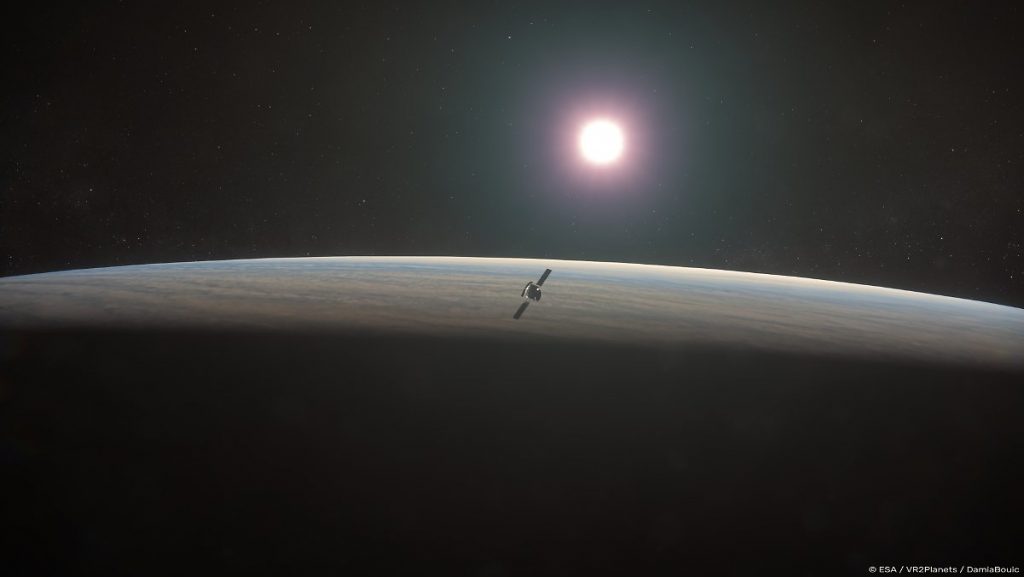Wednesday 16 June 2021
Is the Earth threatened by its fate?
The new attempt at Venus
The new attempt at Venus
from Kai Stubel
Venus could be Earth’s twin – but extreme conditions prevail on its surface. The greenhouse effect turns the planet into a hostile inferno. But how did it come to this? A whole series of new space missions must solve the mystery.
When it comes to life on other planets in the solar system, Mars and Venus are two of the hottest candidates. While the search for Mars has been in full swing for years, Venus hasn’t gotten much attention lately. But suddenly science discovered interest in Earth’s closest neighbor. One reason: From a human perspective, exploring Venus can provide answers to vital questions.
Three new space missions have been submitted to Venus in the past few weeks: At the beginning of June, the US space agency NASA presented its “DaVinci +” and “Veritas” probes, which are scheduled to launch between 2028 and 2030. said Thomas Zurbuchen, Director of Science In NASA: “The Next Decade Will Belong to Venus.” Then the ESA space agency presented the concept of its “Envision” probe last week, which is scheduled to launch to Venus in the early 2030s.
The fact that Mars has served as a landing site for an increasing number of research robots is due to the relatively favorable conditions on its surface. It is very cold there, but such roving vehicles as “Perseverance” can run there undisturbed for a long time. On the other hand, the surface of Venus is a dead zone for all kinds of technical equipment: there is a strong pressure of 900 meters under the sea. Temperatures can reach around 450°C, which causes lead to melt. The Soviet countries of the 70s and 80s rarely survived more than an hour.
Is the Earth threatened with a similar fate?
The massive heat is caused by the massive global warming effect. Venus’ atmosphere is made up of more than 90 percent carbon dioxide. On Earth, carbon dioxide content of just under 0.04 percent is already causing problems. Thick clouds of corrosive sulfuric acid drift across Venus’ sky. What makes the whole thing even more troubling: Venus is practically a copy of Earth. It is about the same size, and its composition is very similar. There are also indications that water may have existed in liquid form on Venus earlier. So researchers wonder whether the planet will degenerate into a glowing inferno over time — and whether Earth could face a similar fate.
Colin Wilson of Oxford University, who helped develop the Envision concept, told the student newspaper Sherwell. Now Wilson hopes that the new ESA mission will find answers.
At NASA, too, they want to understand “how an Earth-like planet could become a greenhouse,” Zurbuchen says. “It’s surprising how little we know about Venus, but the combined results of these missions will tell us something about the planet, from the clouds in the sky, to volcanoes on the surface, right down to its core,” said Tom Wagner, scientists from the NASA Discovery Program. “It would be as if we rediscovered the planet.”
Immerse yourself in the atmosphere of Venus
Certainly the most exciting of the three flower missions is “Davinci +”. It consists of a capsule that is supposed to plunge into the dense atmosphere of the planet and make precise measurements of its composition. The goal is to understand why Venus’s atmosphere is a greenhouse compared to Earth. The onboard camera should also take high-resolution images of the so-called Tesserae, the possible continents of Venus. It is the first US mission to the atmosphere of Venus since 1978.
VERITAS is also supposed to act as an orbiter to map Venus in order to determine the geological history of the planet. In this, too, researchers see key to the question of whether temperate Venus is going the wrong way — and why. In the project, a spaceship equipped with a radar orbits Venus and creates a three-dimensional image of the planet. NASA researchers hope this will provide information about whether processes such as plate tectonics and volcanoes are still active on Venus.
“Is Venus alive or dead, geologically speaking?” – From the point of view of planetary researcher Wilson one of the crucial questions. Radar images of the surface in the 1990s showed that there must have been active volcanoes, at least in the past. It is not possible to determine whether this is the case from the outside due to the opaque cloud cover. The European mission, Envision, is now supposed to discover the thermal signatures of volcanoes that may still be active and locate their gas plumes.
Controversial guide to life
Speculation about the possibility of life on Venus has fueled the alleged discovery of monophosphine in the atmosphere of Venus in September 2020. This gas is considered a biomarker for the possible existence of extraterrestrial life, because on Earth it is only artificially produced by humans or biologically by organisms microorganism. However, to this day, it remains controversial whether researchers have actually discovered monophosphine.
One thing is for sure: After years of loneliness, there will be more about Venus soon. NASA’s last mission with the Magellan probe was more than 20 years ago. The last time Europe sent the space probe “Venus Express”, which orbited the planet from 2006 to 2014. Only the Japanese climate monitoring probe “Akatsuki” is still orbiting Venus. Not only are the European Space Agency and NASA planning new missions, but also India with Shukryan-1 and the Russian Space Agency with Venera-D with which understanding of the alien sister planet – and perhaps even the Earth – must grow.

“Total coffee aficionado. Travel buff. Music ninja. Bacon nerd. Beeraholic.”








More Stories
Coral Seeding: Artificial Insemination Makes Coral More Heat Tolerant
Fear, Anger, and Denial: How People Respond to Climate Change – Research
LKH Graz: Using radiation to combat heart arrhythmias